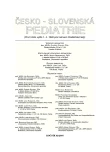Partial Splenectomy in Children with Hereditary Spherocytosis
Parciální splenektomie u dětí s hereditární sferocytózou
Úvod:
Totální splenektomie (TSx) je spolehlivě účinná v léčbě středně těžké a těžké hereditární sferocytózy (HS). Asplenie je však spojena s celoživotním rizikem velmi těžkých, obvykle prudce probíhajících a mnohdy fatálních infekcí, a to nezřídka přes preventivní očkování a/nebo dlouholeté profylaktické podávání penicilinu. Cílem této práce je ověřit, zda parciální splenektomie (PSx) je dostatečně účinná a přitom i bezpečná v léčbě HS u dětí.
Pacienti a metody:
14 dětí s HS středně těžkého anebo těžkého stupně se po předchozím očkování proti opouzdřeným bakteriím podrobilo laparotomii s úmyslem PSx. Antibiotika byla indikována podle potřeby a přeočkování doporučeno za 3–5 let. Jeden chlapec byl vyloučen z analýzy pro krátkou dobu sledování. Jiný se podrobil plánované TSx. Průměrné hodnoty Hb a absolutního počtu retikulocytů (ARC) po operaci oproti jejich průměrným hodnotám před ní byly analyzovány podle úmyslu (13) i skutku (9); porovnán byl i vzestup průměrného Hb a pokles průměrného ARC po úspěšné PSx (9) oproti faktické TSx (5) – vše t-testem na hladině významnosti p <0,05. Zaznamenány byly morbidita, kvalita života, aktivita a školní prospěch.
Výsledky:
Od 2/96 do 2/07 byla laparotomie s úmyslem PSx provedena u 14 dětí (M : F = 8 : 6; věkový medián 7,5 let). Z různých příčin 4 děti přišly o svou slezinu. TSx byla sice účinnější než PSx s okázalejším nárůstem Hb (p = 0,01) a poklesem ARC (p = 0,02), přesto PSx velmi významně ovlivnila Hb a ARC, a to jak podle úmyslu (p = 0,000001 pro oba), tak i podle skutku (p = 0,00002, resp. p = 0,0001). Za ca 55 pr se nevyskytla žádná mimořádná infekce.
Závěr:
Zdá se, že PSx nabízí racionální alternativu k TSx v léčbě HS u dětí. Definitivní závěry je však možno učinit pouze na daleko větším počtu pacientů po delším sledování.
Klíčová slova:
hereditární sferocytóza, splenektomie, postsplenektomické infekce, děti
Authors:
Y. Jabali 1; V. Smrčka 1; F. Chromčák 1; V. Bäumelt 2; V. Louda 2
Authors‘ workplace:
Dětská klinika Nemocnice České Budějovice, a. s.
přednosta MUDr. V. Smrčka
1; Chirurgické oddělení Nemocnice České Budějovice, a. s.
přednosta MUDr. V. Louda
2
Published in:
Čes-slov Pediat 2007; 62 (10): 555-570.
Category:
Original Papers
Overview
Background:
Though effective in the management of hereditary spherocytosis (HS), total splenectomy (TSx) carries a life-long risk of OPSI despite preventive vaccination and/or penicillin prophylaxis. The aim of this study is to verify whether partial splenectomy (PSx) is quite effective and safe in managing HS in children.
Patients and methods:
Upon informed consent, pts with moderate/severe HS were immunized against encapsulated bacteria. PSx, with cholecystectomy (Cx) if need be, was performed 1–6 wk later. Antibiotic therapy was given prn and revaccination recommended after 3–5 yr. One pt was excluded from analysis because of short followup (FU). Another pt underwent elective TSx aged 6.6 yr. Mean Hb and mean absolute reticulocyte count (ARC) during FU were assessed against respective preoperative values in intent-to-treat (13) and as-treated (9) analysis. Moreover, the changes in mean Hb and mean ARC were compared between successful PSx (9) and factual TSx (5). Comparisons were made by t-test, with p<0.05 indicating significance. Morbidity, quality of life, activity, and academic performance were systematically recorded.
Results:
Between 02/96 and 02/07, 14 children (M:F = 8 : 6) with moderate or severe HS underwent laparotomy with the intent of PSx with or w/o Cx. Their median age at operation was 7.5 yr (range, 2.3–18.3; 11 pts >5 yr). PSx was indicated for anemia (8), cholecystolithiasis (3), or both (3). Four children lost their spleen: due to technical infeasibility of performing PSx (1), injury of the retained vascular pedicle (1), and for spontaneous necrosis of the remnant in 2 and 18 months post-PSx (2). In 2 cases, 80 and 100 mL of sanguinolent fluid were drained from abdominal cavity. In 3 pts, 3 viral and 2 bacterial infections occurred. The median hospital stay was 8 d (range, 5–13). Regrowth and/or activity of the remnant were demonstrated after successful PSx, however w/o adversely affecting blood counts. In intent-to-treat analysis, mean Hb increased from 99.4 to 137.8 g/L, while mean ARC decreased from 346,700 to 136,500/μL (p=0.000001 for both). In as-treated analysis, mean Hb increased by 32 g/L (p=0.00002), and mean ARC decreased by 182,300/μL (p=0.0001) post-PSx. However, PSx elicited less spectacular changes than TSx: ΔHb 32 vs 50.2 g/L (p=0.01), and ΔARC 182,300 vs 309,000/μL (p=0.02). Nine pts were FU a median of 5.9 yr post-PSx (range, 4.8–10.4) for a total of 54.8 pt.yr. Over that period, 43 febrile episodes, mostly viral upper RTI, were encountered. Of the 2 hospitalizations for bacterial infection, 1 was on the parents’ wish, the other was in a pt with IBD. Nevertheless, antibiotics, most commonly broadspectrum oral penicillin, were given in 23 cases. Except for 1 boy with IBD developing >3 yr post-PSx and <2 yr post-Cx, all children managed perfectly, enjoyed normal physical activity and performed well at school or work.
Conclusions:
PSx combined with other measures appears to offer a reasonable alternative to TSx in children with HS. However, more pts and longer FU are needed to fully appreciate its true role in the management of this disorder.
Key words:
hereditary spherocytosis, splenectomy, overwhelming post-splenectomy infection, children
Labels
Neonatology Paediatrics General practitioner for children and adolescentsArticle was published in
Czech-Slovak Pediatrics

2007 Issue 10
- What Effect Can Be Expected from Limosilactobacillus reuteri in Mucositis and Peri-Implantitis?
- The Importance of Limosilactobacillus reuteri in Administration to Diabetics with Gingivitis
Most read in this issue
- Partial Splenectomy in Children with Hereditary Spherocytosis
- Multicystic Kidney Dysplasia as a Cause of Hypertension Crisis in a Child with Spondyloepiphyseal Dysplasia
- Early Manifestations of Airways Obstruction at the Child Age
- Does Salt Intake Influence Blood Pressure?
